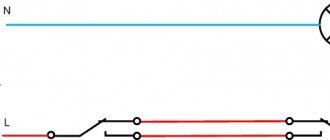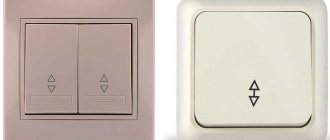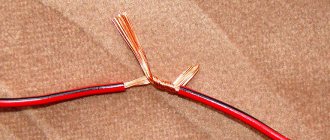- home
- Switches and sockets
Many houses or even apartments have long corridors and stairs. Accordingly, at night they need to be illuminated for safe movement. In this case, the lighting should be such that you can turn on the lamp at one end of the corridor and turn it off at the other. This is a bit of a problem.
Of course, there is a solution to this problem and it lies in connecting and using a pass-through switch from the Legrand brand. Essentially, this switch consists of two switches that are placed at either end of a hallway or staircase.
Its use is very convenient because the light is turned on before entering the corridor, and after a person passes the corridor, he turns off the light using a second switch located at the end of the corridor. This method of operation can be called the main advantage of these switches.
Features of this switch
Pass-through switch Legrand with two keys
It is worth noting that the pass-through switch from Legrand, the connection diagram of which is very simple, is made of materials that make its use not only long-lasting, but also safe.
These materials are galvanized steel and polycarbonate. Elements such as calipers, grips, and screws are made of galvanized steel.
The frame, body, keys and connection mechanisms are made of polycarbonate or ABS plastic. This means that for many years these elements will not crack or be destroyed by ultraviolet rays.
A notable fact is that the manufacturer produces keys, housing and frame in different colors and with different patterns. The lid can also be made from:
- Porcelain.
- Tree.
- May be covered with skin.
As noted in the instructions, the Legrand switch housing itself can have two types of protection:
- IP20;
- IP44.
IP44 housings protect all internal contacts from moisture. The switch itself is secured either with screws or with clamps.
An important feature of the Legrand one- or two-key pass-through switch is the presence of screwless CuZn15/X12 CrNi 177 clamps, which greatly simplifies the procedure for connecting copper wires.
These clamps allow the connection of both single-wire and multi-wire flexible conductors. They are designed for wires that have a cross-section from 1 to 2.5 square meters. millimeter.
Helpful tip: to insert the wire into the clamp, you need to remove 12 millimeters of its insulation.
An important point is that ArNi contacts do not contain cadmium. This element leads to contact contamination and premature destruction. Any disconnector model from this company can operate in conditions where temperatures exceed 5 and are less than 40 degrees Celsius.
It is also worth saying that the pass-through switch is designed for a current of 10 amperes. In other words, the power of lighting devices can be up to 2.2 kW.
Another feature that is an important plus is the presence of an indicator light in some models.
Connecting Legrand switches - diagram
Electrical installation products are used by consumers as functional devices and play an important role in interior design. Therefore, when developing such devices, manufacturers pay attention not only to the technical characteristics, but also to the appearance of the products, trying to ensure that the products meet the requirements of modern design. Among the world's manufacturers of electrical accessories, one of the first places is occupied by Legrand, whose products are distinguished by a variety of shapes and colors.
Connection diagrams
In the future, we’ll look at how you can connect a pass-through switch? As already noted, the use of a pass-through switch requires the installation of two copies. One is installed at the beginning of the room, the other at the end. Their connection depends on the number of keys. First, let's look at the connection diagram for a Legrand brand rocker switch.
Legrand pass-through switch. Connection diagram
The phase wire (L) is connected to the first switch. There are two wires between both switches. Further from the second switch a cable is drawn to the lamp. The neutral wire is also connected to the lamp.
The peculiarity of turning on/off the lamp from two different points is to close/unlock two wires that are located between the switches. To turn on the lamp, one of the wires will be short-circuited.
Wiring diagram for a Legrand switch with two keys
If we talk about connecting two-key disconnectors from Legrand, it resembles what was described above. Their connection diagram is as follows:
Schematic diagram of the operation of a pass-through switch.
Let's immediately figure out how they work in principle.
Unlike conventional switches , which have a fixed position of the power key and simply break the circuit, pass-through switches can be switched on with any position of the key, because they switch from one of two lines to another, which is very similar to switching a railway track switch (see the diagram above ) and allows us to control the inclusion of artificial light from different places.
The phase comes to the first pass-through switch, and from the second it goes to the lamp , and both of them must be connected to each other with a two-core electrical cable or wire. But, as a rule, no one connects them directly, but three separate wires from each are inserted into a junction box and two of them are simply connected in pairs to each other .
When connecting additionally, if necessary, a third, fourth, etc., the circuit essentially does not change, but their connection differs from the first two, which had one input contact and two output ones. They will need to have two input and 2 output wires connected, allowing them to be used to cross-switch between two lines.
The operating principle of the third pass-through switch (when purchasing, pay attention to whether it has the ability to work as a cross switch) is that when switching, it connects the first contact at the input to the second at the output, and the second contact at the input to the first at the output. To connect it, you actually need to connect it to two other pass-through switches with a 2-wire cable, but no one does this, but run the 4-wire cable into a junction box and make the connection there according to the diagram.
Similarly, you can add a fourth to the circuit, which will be located between the third and second or first switch.
We have looked at the theoretical part, let's now look at specific practical schemes.
Installation features
Now let's turn to the installation details. According to the instructions, the Legrand pass-through switch can be installed in open or closed mounting boxes. The fastenings in these boxes are done either with clamps or with screws.
Before installation, you need to remove the frame and key. They are attached using special mechanisms and have special grooves on the side. First, insert a flathead screwdriver into the key groove and lift it up.
Next, this same procedure is carried out relative to the frame. Now you know how to properly disassemble a Legrand pass-through switch.
After this, attach the base of the device for turning on the light to the installation box and connect the wires according to the presented diagrams. At the end, the frame and the upper part of the key are mounted.
The process of connecting the Legrand switch is also shown in this video:
Leave a comment Cancel reply
Related Posts
Sockets built into the tabletop save desk space and do not spoil the appearance
DIY triple socket installation. How to carry out the work.
Connecting a double socket into one socket box
Correct and convenient installation of sockets in the apartment
Connecting Legrand switches/switches
Installation of Legrand switches/switches is carried out in accordance with the attached instructions. In addition, the connection diagram is duplicated on the back of the product.
How to connect Legrand switch
For a correctly connected Legrand switch (two- or single-key), the keys in the on state occupy the “up” position, and in the off state, the “down” position. To do this, the phase wires are connected to the input terminals, which are marked with the letter L or arrows indicating the path to the center of the switch. In this case, the conductors going to the load (lighting lamps) are connected to the output terminals, indicated by arrows indicating the direction from the center of the switch.
If you connect the phase wire to the output terminals, and the wires going to the load to the input of the switch, the key will be in an inverted position and there will be a danger of electric shock to the user when replacing the light bulb, which will be energized after turning off.
Connect the switch in the following order:
A two-key switch is assembled from two single-key switches, so the connection diagrams for each half are identical.
Connecting a Legrand switch with backlight and indication
An additional lamp in switches is used for the following purposes:
The load indication mode is activated only if not only the phase wire, but also the neutral wire is connected to the input contacts of the switch.
Source
What are Valen switches for and how to connect them
Published: 10/31/2018
The switch is the big brother of the switch. In appearance, he is no different from him: the same features and forms. The whole difference lies within. To recognize who is in front of you, just look at the back of the mechanism. It will immediately become clear what kind of animal it is: a switch, a switch, or even a cross switch. Let's figure it out.
Single key switch
This mechanism has two working contacts. Its task is to close and open the circuit. Connection locations are indicated by arrows. This is where the phase wire should be placed. The contacts are self-clamping, there are no screws. They pressed the foot, wound the wire and released it.
Single key switch
There are already three contacts on board. Two of them are always closed. Which? Depends on what position the key is in. When the mechanism operates, a change of closed contacts occurs, that is, switching. Hence the switch. Another name is a pass-through switch. Apparently because it went through and turned off. Controlling lighting from two points is the main task of three-contact devices. The switches are initially designed to work in pairs.
And yes, a switch can replace a switch, but not vice versa. This is convenient if there are no simple switches available, but the mechanism is very necessary. The only issue that comes to the fore is the issue of price.
This designation is present on the back of the mechanism. According to Legrand marking, this is an STD 6 circuit
How to connect?
Connection locations are indicated by arrows. A phase is supplied to the single contact of a switch, then the paired contacts are connected to each other, and one of the load contacts is connected to the single contact of the second mechanism. The diagram is assembled.
Scheme
Let's look at Legrand's brochure with diagrams. The operation of the switches on it is as follows.
If you redraw it visually, you get the following picture.
Let's say we are on the left. No current passes through contacts 1-3-5-6. The light is not on. We flipped the left switch and the light came on. Current flowed through 1-2-4-6. The room became light. Let's walk, for example, along the corridor. Now the task is to turn off the light. We click the right switch and voila, the circuit is open, the light goes out. No current flows through 1-2-5-6. Can be repeated in the opposite direction.
And this is how a single-key switch with indication is designated.
Single key cross switch
Longest title. All that is clear from it is that he will cross something. Let's figure it out.
As you can see from the diagram, the mechanism has four contacts inside. The crossbar is placed between two single-key switches. Each pair of its contacts is connected to “paired” contacts of the switches. When such a mechanism is connected to a circuit, an additional point appears from where you can turn the lighting on and off.
Here is the connection diagram.
Two-key switch
Essentially these are two switches in one housing. He has six work contacts.
The connection diagram will be like this. We look from left to right. We connect a phase wire to the “single” contact of the first (left) switch, as in the case of a single-key switch, connect two adjacent contacts on the other side to two adjacent contacts of the second mechanism, and connect the wire to the load from the bottom of the key. We do the same in the other direction, starting from the second (right) switch. This completes the diagram.
Valena does not have a two-key cross switch. It's an interesting thing though. It would have eight contacts. Four for each key.
But Schneider's Unica has such a mechanism.
Installing a Legrand light switch: device features
The mechanism consists of five elements. For correct installation, you need to understand how each part works.
- frame;
- frame;
- terminals;
- buttons and contacts;
- the base on which all elements are located. It is this that allows you to securely mount the product on the wall or attach it to the mounting box.
The French manufacturer makes the base from galvanized steel. This material is not subject to deformation, therefore it provides the most reliable fastening. There are four mounting screws on the back side. Installation of the Legrand light switch is possible in a mounting box of any size.
The shape of the fastenings is universal. It allows you to adjust the position of the device - rotate it in any direction and center it.
For convenient connection of wires, automatic terminals are provided. Connecting cables is as simplified as possible: just strip the wires and insert them into the terminals. The latter are often located at an angle of 35°.
The manufacturer took care of the user. He provided a marker on the back panel. Based on it, it is easier to understand how much insulation needs to be removed.
What types of Legrand switches exist?
Based on the type of installation, these devices are divided into:
- Invoices. They are installed with the wiring open. These are the Quteo, Oteo, etc. series.
- Built-in. These devices are distinguished by a mechanism recessed into the wall surface and are used with appropriate wiring (hidden). At the moment, this is the main type of switches used in residential and office premises.
Read also: Formula for calculating wire cross-section by diameter
By type of on/off they can be:
- Keyboards. This is the most common type of switch. Today, they are equipped with a larger number of lighting systems in living rooms and office spaces. Moreover, devices consisting of two or more keys can control entire groups of lighting fixtures. At Legrand, such switches are presented in almost every series (Cariva, Quteo, Anam, Galea Life, etc.).
- Sensory. These are devices that use innovative technologies to control lighting. They work with a simple touch, and sometimes to turn on the light you just need to move your hand next to them (Celiane series, etc.).
- Equipped with IR sensors. Such switches have built-in devices that respond to movements and activate the lighting at the moment a person appears, and, accordingly, turn it off in the absence of people. Such devices are available in the Valena series and others.
- Push-button. These devices that control room lighting have not been used for very long, so they bring originality and freshness to every interior. They are quite convenient to use, but require some time to get used to (Celiane series, etc.).











